Katherine Morton SNU Project - Non-Verbal Performance in Animation
Don't wanna be here? Send us removal request.
Video
tumblr
SNU – Animation:
This is my experimental animated sequence that investigates how body language can be used to communicate non-verbally to an audience. To observe the influence body language has on performance, I decided to not include facial expressions and dialogue in my animated sequence, as I wanted to find out how kinesics would be interpreted without facial expressions in performance. My sequence is influenced by my research on the psychology of body language and behaviour, and Laban Movement Analysis (LMA), which helped me to identify realistic body language, and decide how I can implement it into the animation medium effectively. I am pleased with the outcome, however, I would have liked to refine some of the gestures more to make them clearer to the audience. When creating my animated film for my Master’s Project, I should refer to my research and experimentation in this project to push my character’s animated performances, as well as make my animations rely more on showing the audience, rather than telling them, as this will make the audience empathise more with the characters.
poyraz (2018) Body Mechanic 3D model [3D Digital Model]. Available at: https://www.cgtrader.com/free-3d-models/character/man/body-mechanic-rig (Accessed: 04 February 2020).
0 notes
Text
SNU Reflective Journal Weekly Summary (Week 16) 8/05/2020:
This week, I have finished animating the keyframes for my animated sequence. The full sequence is about 30 seconds long, which is longer than I anticipated. I wanted the sequence to be fully polished and splined, however all the key poses are present in the sequence, so the action is depicted clearly.
I wanted to experiment with how body language is affected by emotion to improve my animation skills, but also to see the effect a character’s subtle movements and gestures have on the audience, and how they empathise with this. I sent my animation to a few people to ask them how they thought the character felt, and why they thought this. The feedback stated that the character’s performance reflected a tired feeling, and they could detect the change in emotion halfway through the sequence. This suggests that the audience were able to empathise with my animated sequence, which implies that it was successful. However, my sequence had a simplistic narrative, which may have made it easier to identify.
It is also important to mention that the variation in body types, gender, and personality would all have an impact on how a character’s body language is presented, as some people may be more expressive in their physical movement than others. When creating character animation in future, I should consider how these factors would affect an individual’s movement and gesture. If I continued to experiment with this project, I would consider creating different sequences with more complex narratives, as well as more complex or difficult to read emotions, to see how an audience would interpret it, as this would help me to determine whether nonverbal body language can be successfully used on its own in more detailed context to communicate to an audience. Whilst the sequence is not as polished as I wanted it to be, as I think that the movements could be refined in places, such as when the character is wiping the rain from their face. I found it beneficial to experiment with how body language can be used to communicate in a nonverbal way, as this has helped me to consider how I can use a character’s body movements as part of their performance when facial expressions cannot express an emotion that body language can. By experimenting with this, it has encouraged me to think about how a character’s body movements and gestures can be used as an additional method of communication, which I want to work toward implementing into my Master’s Project.
I also decided to write a draft screenplay for my Master’s Project. Due to the Master’s Project being delayed until September, I thought that writing a draft screenplay now would help me to develop the story, but to also remind me of my ideas for the narrative. Whilst the screenplay is rough and needs more narrative in areas, I can continue to build on my ideas, and I can begin to create some visual concepts in the future to prepare for my next project.
0 notes
Video
youtube
Mike Hermes (2015) Maya 2016 tutorial : How to create rain using nParticles. Available at: https://www.youtube.com/watch?v=GY66aqxTr4k (Accessed: 7/05/2020)
SNU - Research:
I wanted to add rain to my animated sequence, and found a tutorial on how to add rain as nParticles in Maya. I found it difficult at first to control the speed of the rain, however I found out that this was due to the playback settings not being set to play every frame. Once I had edited the settings, the rain effect worked at the speed I wanted it at. I wanted the rain to gradually increase in amount as the scene played, as I wanted to show the character responding to the rain. I had not used the nParticles for this type of effect before, but I found it worked very effectively, and I may consider using it again in my future projects, as I would like to experiment more with visual/particle effects in the future.
0 notes
Video
tumblr
SNU – Development:
This is another work-in progress video that demonstrates my daily progress. I wanted to render some videos of my daily process so I can see my experimentation and improvement to the character’s poses. I found that the character’s walk did not look right with their arms swinging, even though this was what was represented in my reference footage. I decided to refine the arm swings to make them subtler, which I think has worked more effectively for my animation.
It is unfortunate that the model did not have fully moveable fingers, as this would have allowed me to add more subtle details to the hand movements, however the model itself was easy to manoeuver, and had a responsive rig with a suitable amount of controls to recreate realistic body movement in almost every area. In addition, there were controls on the hands that would allow for independent thumb movement, and the option to close and twist the hands, which I found very useful in my animation. I would agree that if I created further animated sequences, I would use a character model that had separate fingers, as most actions would require the ability to isolate and move separate digits to convey the action appropriately, such as someone tapping a desk in boredom.
0 notes
Text
SNU Reflective Journal Weekly Summary (Week 15) 1/05/2020:
I have continued to animate my animated sequence this week. I have blocked out most of the animation, and have experimented with the timing of the movement to reflect the slow, tired movement of the character. I have decided that the sequence will reflect a tired character who gets caught in the rain, which changes his emotion to irritated. I will show the change in body language for this by making the character perform with actions closer to their body, as opposed to the tired poses where their body is loose and their arms move limply and tiredly as they walk. I decided to change the emotions slightly as I was concerned that the change in emotion would not reflect enough in the body language, and that the emotion needed to have a physical, outward reaction to indicate to the audience how they feel. I thought that by making the character irritated instead of angry or upset would contrast better with the tired feeling, which would enhance the performance. I found blocking the walk quite challenging, as I wanted the character to have a slow paced walk to emphasise their tiredness. This made breaking down the 4 parts of the walk over 25fps difficult, as sometimes I had to use 24fps timing to ensure that the contact or the pass pose did not come too early, as this would affect the slow pace of the walk. I am pleased with the result so far, though I would like to spline the animation as much as possible to refine the walk. I would also like to add rain effects, as I think that this will enhance the realism of the piece, and will allow the character to interact with the environment in the scene too.
I have decided to note down my work-in-progress for my screenplay, writing down the key elements of the story that I have developed so far. I have decided that I will write the screenplay during my Master’s Project, as I think that this has more relevance there. However, the ideas that I have started to generate, as well as the research I have started on narrative, has been useful to start structuring my story ideas for my animation in my Master’s Project. In addition, I decided to create my ASU2 sound project using one of the characters and their world, based from my notes in this project, so I would argue that this research has been important to planning my next project, and also helping me improve my narrative structure for my ASU2 project.
0 notes
Photo
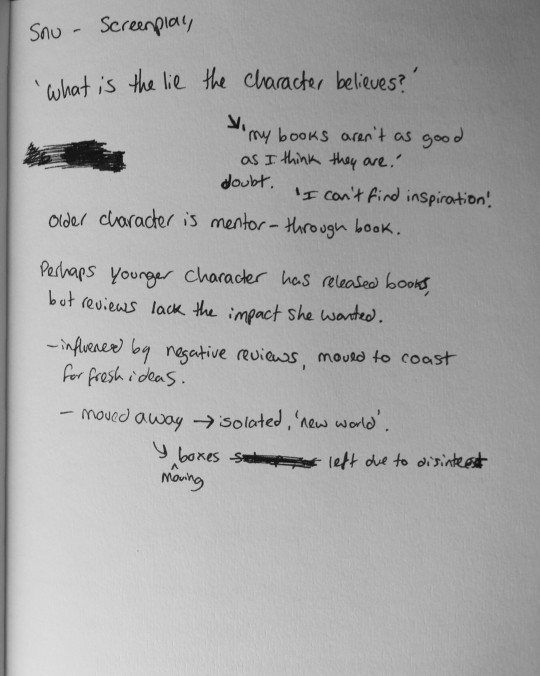
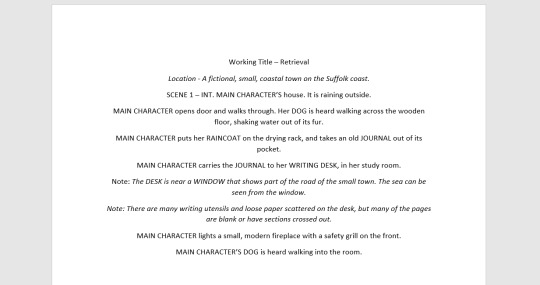
SNU – Experimentation:
I have been writing down some more of my ideas for my screenplay draft for this project. I have thought about what the character’s goal could be in the story, and have been experimenting with different ideas. I have decided that the main character will be a writer, as I think that this would reflect her personality well. In addition, the character needed a reason to go to the coast, and I think that she would try to write about the seaside for the different visuals and lifestyle in comparison to a urban city.
I have started to write my draft screenplay as well, focusing on creating narrative beats that will tie the story together. I want the story to follow the protagonist, as if she is reading the journal, interested in it as she herself is a writer. Moreover, I want the animation to have eye-catching visuals, so I have been describing some of the items or important details that I want to be visible on-screen, as this helps me to visualise the scene better.
I will finish the screenplay in my Master’s Project, as it will be more appropriate to tweak it alongside the character design and visual design of the film that I will develop in my next project.
0 notes
Video
youtube
SNU – Development:
This is a work-in progress look at my tired character animated sequence. I have rendered dailies of my sequence so that I can look at the process of my animation, and see how it is developing each day as I work on it. I decided to keep the character model I had tested for my Pecha Kucha Presentation animation test, as I felt that this model was the most appropriate one for this project. I have found other character models that have fingers, however they are detailed in other aspects, such as having facial features, hair, and clothing, which I did not need to animate for this project. Whilst it would be beneficial to see how these elements create secondary animation alongside body language, I think that this will be more appropriate to experiment with in my Master’s Project animation, where I intend to animate characters with more complex details like hair, and other accessories.
In regards to the animation, I have started to block out the key frames of the walk, starting with the down pose as I knew that this would be the most extreme pose, followed by the up pose. As I want the character to have a slow walk, I experimented with the pacing of the walk; I found out that some of the strides were too wide for the character to walk at their current speed, as the body’s forward force would push them too far for the foot to stay balanced. In the last version in this video, I adjusted the character’s foot placement so that they were not taking too many long strides, but I made the distance slightly different each time to emphasise their weariness, and to show that they are being clumsy with their movements when walking. I also made the arms swing limply to enhance this, however I think that it looks too exaggerated, so I will adjust this to make the movement believable, but also more subtle, as I think that this will subtly communicate the character’s body language as more tired than lazy.
I decided to give my character a backstory to influence the character’s walk. I imagined that the character is walking home from work, tired from a long day, and he forgot his umbrella. This leads him to be frustrated when it rains. By animating the sequence with this factor, I think that the character’s performance is enhanced.
Williams, R. (2009) The Animator’s Survival Kit. Expanded Edition. London: Faber and Faber.
0 notes
Text
SNU Reflective Journal Weekly Summary (Week 14) 24/04/2020:
This week, I have been blocking out the character animation for my animated sequence. I have been finding it useful to refer to my visual reference, but also to both of my animatics, as I can look at how the body moves in real life, as well as look at my more exaggerated drawings and decide which pose would be the most effective in my final sequence. I have started by animating the first part of the character’s walk, where they stop in the middle of the scene to catch their breath. I want to make the character’s walk slow, with a rhythmic pacing to reflect their tiredness, but to also give the animation stronger beats. I have decided to start with the down poses in the walk, as well as the up poses, as these are the most extreme poses in a walk, and I think that they will be the most extreme poses in my character’s walk in my sequence. In contrast, I consider the contact and pass poses to be weaker in this particular walk, as they may look more like in-betweens due to the slow break between the down poses to the faster up and pass poses. I also decided to keep the character model I had, as I was unable to find a similar model that had no facial features. However, the sequence I have chosen does not rely on using the character’s fingers as much, although I would agree that ideally the character should have fingers to create the best movement possible. Despite this, the character model works fluidly, and the lack of facial features means there is less distraction for the audience, but also it encourages me to use the character’s body more to exaggerate their movements, as they cannot use their facial features to emote. In my Master’s Project, I intend to use character models that have fingers to be able to express their nonverbal body language clearer, so I will be able to experiment further with using the character’s hands to communicate in future projects.
0 notes
Photo

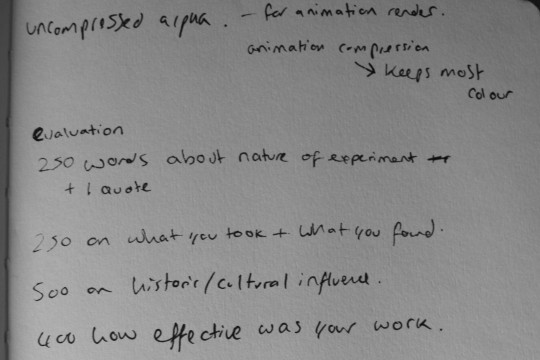


SNU – Session (Online) (Week 14) 22/04/2020:
This week, I had an online group tutorial in which we discussed our work-in progress. We were informed on how we can write our critical evaluation, and how we can critique our work appropriately for it. It was recommended to us that our evaluations reflect upon our proposition, experiments, and evaluation of our findings, commenting on challenges we faced, and unexpected findings or results from our project.
I have started to create a draft version of my evaluation, making notes on the important factors of my project, but also keeping it balanced between my reflection, my research, and my experimentation.
0 notes
Video
youtube
SNU - Development:
These are the final versions of my animatics. I decided to animate sequence two for my animated sequence, as it expressed the emotion clearly, and had a clear change between emotions, which I felt that sequence one and three were less effective at expressing. Whilst I like the perspective of sequence three version two, I felt that the narrative and character performance were not dynamic enough for the aim of my project, which is to experiment with character body language in a nonverbal way. Sequence two also allows me to animate a character reacting to something, as I intend to create a rain effect in my animation for the character to respond to. This will also allow me to practice my skills in adding particles to a 3D scene.
0 notes
Text
SNU Reflective Journal Weekly Summary (Week 13) 17/04/2020:
I decided to create alternate versions of my animatics to experiment with how the character is perceived through cinematography. I wanted to see how different camera angles and camera shots affect my sequences, as I have created them from a single wide camera angle, which is effective, however I wanted to see if I could enhance the character’s personality through another non-verbal method – the camera. From my research into cinematography, I can see that the camera is important to communicating the narrative, as well as show what the character is thinking, so it will be important to use the camera effectively in my animated sequence, but also in my future animations as well. For my SNU project, I may render two versions of the same sequence with different camera angles, and ask people which sequence they prefer and which one helps them to understand the character’s emotion better to help me experiment with camera angles, and to see how effective they are in communicating a narrative with no dialogue, and how I can improve the character’s emotional connection to the audience without including facial expressions.
From the alternate animatics I have created, I think that the sequence where the jar falls is the most effective with multiple camera angles, as I think that this communicates the thought process of the character in a more concise way than the single positioned camera. I found it difficult to draw the perspective of some of the poses, especially when viewing the camera from the front, as I struggled to create the level of depth that I wanted on the character, which resulted in the character’s body being slightly inconsistent in some cases. However, I wanted the animatics to communicate the movement of the character, as well as the narrative progression in the sequence, as I intend to represent the character’s body language and gestures in the animation. I think that I will animate the sequence where the character is tired, as I want to experiment with subtle and exaggerated body language, and I think that this scene effectively represents both, starting with the character being tired, then becoming irritable and frustrated. It will be interesting to see how I can visually show the build-up of frustration without facial expression; I think that indicating tension and quicker movement in the character’s body may be the most effective way to communicate this to the audience.
This week, I will block out the animated sequence, focusing on the key poses the character makes. I intend to add subtler body language and gestures; however, I am aware that these are likely to only be noticed in a complete animation, and may be missed if the animation is incomplete. Nevertheless, I intend to create the animated sequence that shows a change in the character’s emotion, and has a simplistic narrative for the character to perform in. I will also write a short prompt/backstory to show the character’s intentions and personality, as I have realised that this will also influence the character’s behaviour and body language in the sequence. I intend to make the character’s body language as clear as possible, as the aim of the experimentation is to see the effectiveness of non-verbal body language on character performance in animation.
0 notes
Video
tumblr
SNU – Experimentation and Development:
This animatic was a test to see how much the camera could reveal to the audience about the narrative and the character themselves in my sequence. I think this could be more effective with a more detailed narrative, especially if the character interacts more with another object. I think that the camera would also be more effective when there is more than one character, as they can interact more, which allows for more uses of camera angles. I have decided to create sequence two as my chosen animated sequence, as I think that the feeling of tiredness is depicted the most effectively through body language. Also, the sequence will have a combination of dynamic and subtle movements, which will be beneficial for me to practice my animation skills.
0 notes
Text
youtube
DSLRGuide (2015) Camera Movements – Storytelling With Cinematography. Available at: https://youtu.be/J9APrV5cYnE [Accessed: 11th April 2020]
SNU - Research:
This video shows that cinematography has an influence on how the narrative affects the audience. When the camera moves with the character, the audience can empathise with them more, as they learn as the character learns. In contrast, the camera can stay whilst a character moves, which can create different atmospheres depending on the narrative of the scene. For my project, I have decided to create alternate versions of my animatic sequences to experiment with the effectiveness of the camera placement in the scene, as I want the character’s body language to communicate to the audience effectively.
0 notes
Text
SNU Reflective Journal Weekly Summary (Week 12) 11/04/2020:
This week, I have been developing my characters for my Master’s Project short film. In my SNU project I still aim to create a rough screenplay, outlining the key story elements I plan to include in my final film. I have noted down some ideas, and have changed my character from a painter to a writer, and the older character from a painter to a gardener. I decided to make changes to these characters as the painter trait did not have an effective conflict for the main character I am developing. On my ASU2 project, I am creating a sound piece inspired by my main character, setting the narrative to be shortly after she moves house to the seaside town, before the events of my short film. I experimented with manipulating sounds, and decided to manipulate the sound of a seagull to echo. I have been developing my characters more, and decided to make the main character have a fear of seagulls to show her human nature, but to also give her flaws that are not only relevant to the narrative. I have also decided that the main character will be a writer, who has moved to a fictional Suffolk seaside town to improve her writing. She is flawed, and is influenced by critics’ reviews on her previous books, which suggests that she has been writing for a while, but has also been writing to please critics. She thinks that by changing environment she will have inspiration for a new book, learning to appreciate her own writing more with the help of the natural environment and the character from the past, represented through their journal. Whilst this story is still being developed, I feel that I am understanding the characters more through their personality and small traits. I have decided to create a character bio for both the main character (young woman) and the past character, who I have yet to develop, however I know that they will be the village/town gardener, and gardener to the coastal plants on the coast as well. I decided to choose a gardener as I wanted to find an appropriate job for the character, as they are in post-world war one (About 1920), and I felt that a gardener was a solidary, calming job that the character could do, and during their breaks they could record the plants and flowers they have planted in their journal with some information about them (so they can remember), but also to write short journal entries recording interesting or noteworthy things in the day. This will also help the narrative to have an effective 5-act structure, eventually building to the climax and resolution.
I also want to include as much visual environment inspired by Suffolk as possible, and I thought that by making the character a gardener, I can include a variation of wild plants and garden plants from Suffolk. This also helped me to link the purpose of the journal to the two characters – the gardener can record the plants, and write about them in the journal, and the main, present-day character can find it near the coast and be able to reference the plants in their book, essentially inspiring the main character through the journal. I am still deciding whether I want the main character to create a fiction book based on the past character, or to simply gain inspiration from their journal entries and plant care. These are areas that I need to develop further in my narrative to ensure that my story is concise, but also has an effective 5-act story structure that the audience can engage with. I aim in my Master’s Project to make a short animated film that has an interesting and effective story, but also has characters that are unique that the audience can empathise with.
I also want to experiment with 2D and 3D animation elements, though I am using my ASU2 project and my Master’s Project to consider 2D animation styles for this. My biggest concern with the project is the consistency of the 2D and 3D animation, as I am not creating my own character model for the 3D animation. I will create the past character’s design myself in 2D animation, however I am still deciding whether to use 2D animation in the 3D sections, essentially using the 3D animation I create as a tool to rotoscope into 2D drawings. In my ASU2 project I am researching how 2D and 3D animation are used together to create a consistent style of animation, so I may be able to find a solution to this in that project.
0 notes
Photo
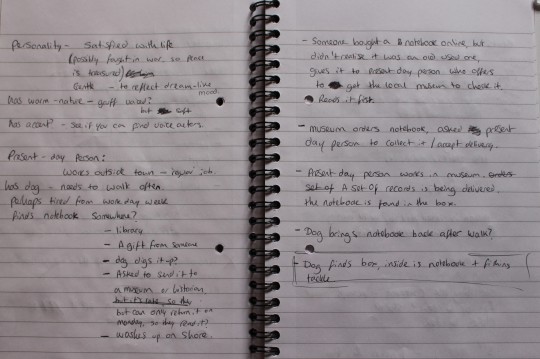
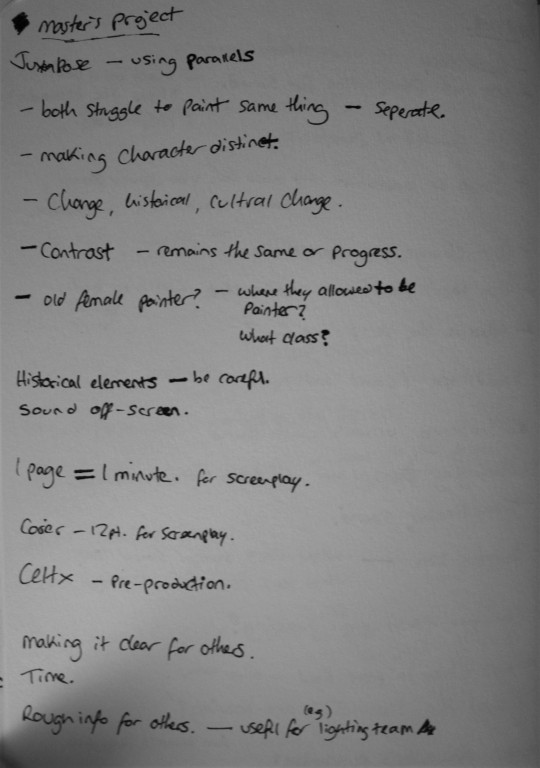
SNU – Development:
I have started writing more story ideas for my narrative for my short animated film for my Master’s Project. As well as this, I have also decided to create a character biography or backstory to help me understand the characters to develop them for my short film. For ASU2 I am creating a sound piece themed around my main character, so I thought it would be important to understand the character’s ambitions, and why they have made their decisions, such as moving house, so far. After analysing narrative elements and structures, I am starting to write a draft story plan with the key elements that I want to include in my short animated film. I may still tweak ideas, as well as the screenplay, when I begin the Master’s Project, however I want to start solidifying my ideas now so that I have time to change them if I need to re-write a scene to improve the narrative. Feedback will be important to me as I continue to develop this project, however I think that feedback at the story writing stage will also be beneficial, as I will be able to make changes to my story without needing to re-create any visual elements.
0 notes
Video
tumblr
SNU – Experimentation and Development:
I have started to create animatics for the three sequences I have chosen to develop. In this animatic, the happy character is walking until a vase falls in front of them, startling them and causing them to stop. They then proceed to look around for any people, and then slide the broken vase pieces to the side with their foot. The character then continues walking in a happy manner. I am also planning to animate two other sequences, one depicting a tired character, and another depicting a cross character. I wanted to use varied emotions and feelings for my sequences, as this will help me to determine the effectiveness of the character’s nonverbal body language.
0 notes
Text
SNU – Experimentation:
I am deciding whether to use multiple camera angles or one fixed camera angle for my animated sequences. I want the character’s body language to be recognisable, and am concerned that by including camera shots where most of the body is not seen, such as in a close-up, that the nonverbal body language will be difficult to read. By changing the camera angle the emotion and atmosphere of the shot will change, and this will either have a positive or negative effect on the character’s performance. Lighting and colour will also have an effect, however I want to focus on communicating the character’s body language in a controlled environment, so I think that I will experiment with colour and lighting in my ASU2 project where it may be more effective. I plan to create animatics of my scenes, and may consider creating animatics with different camera angles to determine which sequence would be best to create with multiple shots or single fixed camera.
0 notes